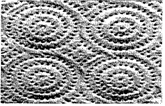 CFI mops up sponge appeal
CFI mops up sponge appealYesterday the Court of First Instance dismissed an application to register as a Community trade mark a ‘motif gauffre’ (yes, it’s another French-only decision …). It’s Case T 283/04 Georgia-Pacific Sàrl v OHIM. The applicant sought to register a sign (above, right) for what look like paper rolls, napkins, serviettes, sponges etc in Classes 16 and 21. Not distinctive said the examiner; not distinctive, said the Board of Appeal; not distinctive, agrees the CFI.
The IPKat agrees that the sign isn’t exactly what you’d call distinctive, but he wonders if there isn’t more to it, since the CFI’s decision takes up 62 paragraphs. So, if you speak French and love trade marks, please let us know …
How to clean kitchen sponges here
Killer sponges here





![[GuestPost] G1/24: Tuning in! A take on the state of proceedings before oral proceedings](https://blogger.googleusercontent.com/img/b/R29vZ2xl/AVvXsEjZhEivE5bp7QOwZsyZXAXbVNYSmLjUthkB2Q7fm1_dpB97u5lIQeyWT9ZadUTAH3Z-hXn13VpW4vBDRPx9emCnoDV6tbUTkyvfmqPv1nNInL8XMdrAtSZ2hcRQr2LjxKovC9wTk_XyZxQ0CtX1MUrO_Muz3OJ4ld8AftymsdUmKD7xNksYMwk6/s150/Picture%201.png)
![[Guest post] ‘Ghiblification’ and the Moral Wrongs of U.S. Copyright Law](https://blogger.googleusercontent.com/img/b/R29vZ2xl/AVvXsEhxl1BQBAW3Y-asjb1xXB9eA4DYy77fky6WgR-prC-_6DeBbDqOgCUDWyiz0Q3B23MWWAXnkbS2H2js7OUwA0JQXAHmsyVFgGIHeJz7zJ791vTzOD-4SJqWFIuywFXQyd3ahybbdZd4e8IEVfcNqctvyR8lumv_Gix6Tsw5cSvbHpTI1nwvztDuAQ/s150/IMG_2179.HEIC)


![[Guest book review] The Handbook of Fashion Law (with a discount code)](https://blogger.googleusercontent.com/img/b/R29vZ2xl/AVvXsEgB4h2AdqJKwq9O3Ft4Mb7C39tv_NeFpkzrOfvhIsuwAkM_ops2Hgj7fdwzq_TQsjQDvQrQa-yyC9Q9pNiugseXRlUaMdsr_cmYUbh9lH8HDECMCbsTuNboVgpafyEhkgDkVS6ruHkuz8Sx0QVGI_1S8R9kbsHdNIYrRjqhyphenhyphen010_txjJUYvlZOtWA/s150/Fashion%20Law%20Book%20Bicture.jpg)







As a lover of trade marks and French, I have managed to soak up the following points:
ReplyDelete* In trying to overcome the objection by the examiner, the applicant restricted its specification to, effectively, paper towels and filed evidence which it claimed showed that the mark had acquired distinctiveness, namely the results of a survey in ten member states
* Unfortunately, the examiner and the Board of Appeal did not like this evidence and did not consider that it showed that the mark had acquired distinctiveness. Indeed, in its submissions to the CFI, OHIM claimed that this evidence showed that the mark was not capable of distinguishing the applicant's goods from those of others.
* The CFI held that where a mark which had no verbal element was concerned, that mark would have to be substantially different from the norm in order to perform the essential function of origin. Since the majority of people in the survey did not associate the "waffling" (of the towels, not the CFI...) with a particular brand, the mark was not distinctive in fact
These are just a few highlights but it is interesting to note the scathing treatment which the survey evidence received and that if a mark is "non verbal" it is likely to face an uphill struggle unless it is performing a trade mark function.
Thanks for this, Chris. You've been hugely helpful. It seems to me that the CFI's position on distinctive waffles is the same as that which it - and I think the German courts - have taken with regard to bottles too.
ReplyDeleteSeasoned and somewhat weary CFI watchers will know that 62 paras doesn't a new legal principle make.
ReplyDeleteNevertheless nice to see the CFI spot on again (Goodness knows they've had enough practice).
I think the real question should be: how do these no hope signs get as far as the CFI in the first place ?
The Kat has received this comment from his friend and hero Tibor MBE:
ReplyDelete"Gaufre/gaufré = embossed, so we are here dealing with embossed paper kitchen towels for mopping up spillages etc.
No need to worry about the 62 paras. It's just long-winded to say that, as usual, the public is not used to see TM significance in patterns/shapes, relies i.a. on Glaverbel. And in casu, the BoA was right that this pattern was more of an aesthetic matter and not an 'origin' one. Again as usual, the CFI said this pattern is any case not significantly different from other embossed paper towels.
There is a wee bit more about the argument that one cannot see the embossment at the time of purchase but that was brushed aside, as was another feeble one about the technical function of the embossments.
In short, nothing surprising in the slightest (except that folks are still fighting such impossible fights)".
Many thanks, Tibor.